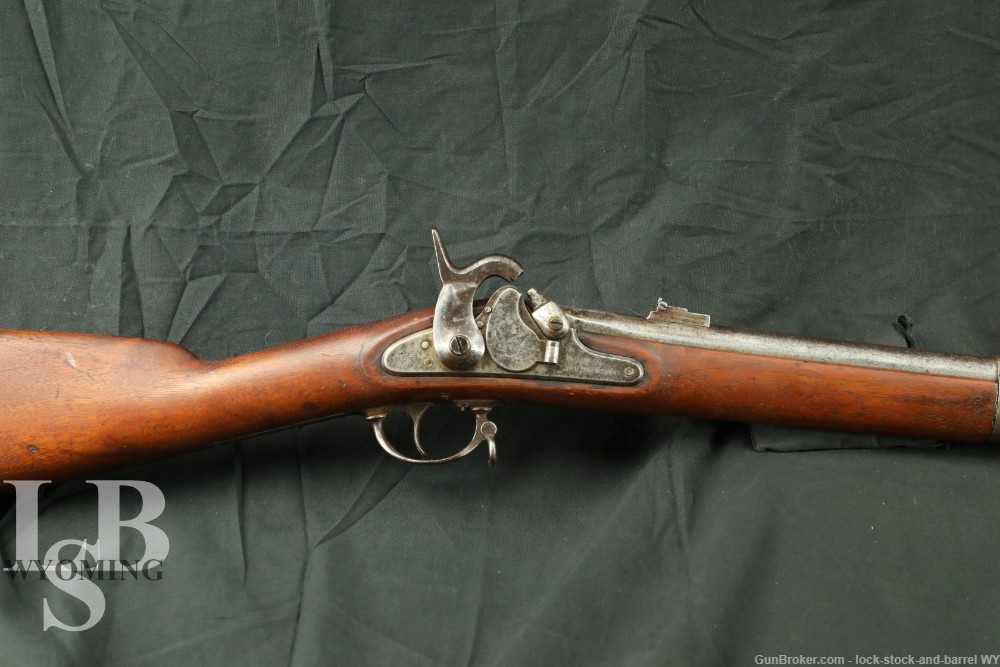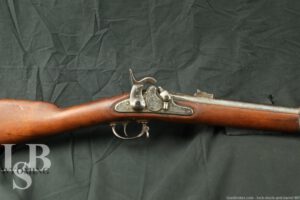
Springfield 1855, 58 Cal. 40” Percussion Rifle Maynard Tape
SOLD FOR: $1,471
WOA#: WY240311JH001
Make: Springfield
Model: 1855
Serial Number: NVSN
Year of Manufacture: 1859
Caliber: .58
Action Type: Maynard Tape Percussion Muzzleloader
Markings: The Lock Plate is marked “1859” / “US SPRINGFIELD” And the Door for the Maynard tape is marked with an “Eagle with Striped Shield” The top of the chamber is marked “1859” the left side of the chamber is marked “V” over “P”. The top of the butt plate is marked “US”
Barrel Length: 40 inches
Sights / Optics: The front sight is a blade perched atop a block sight. The rear sight is a three piece leaf with “V” notch . The three blades are graduated for distance.The second and third blades are marked with a 3 and a 5. In good condition for their age the short range sight has been broken over the years and shows damage from field use, but is still viable.
Stock Configuration & Condition: The stock is in outstanding shape. Showing only handling marks and no major defects. The LOP measures 13.5 inches from the front of the trigger to the back of the Steel buttplate. The stock rates in about fine overall condition.
Magazine Quantity & Condition: none
Type of Finish: Blued and Patinated
Finish Originality: Original
Bore Condition: The bore is brown. The chamber retains its reflective shine. There is some erosion in the bore. In this writer’s opinion the bore rates 7/10 for its age.
Overall Condition: This Musket retains about 25%> of its metal finish. THe action works and the Maynard Tape Door and Springs are intact. The balance of the finish shows wear from light handling over the last century. The screw heads are Serviceable and not marred. The pins are serviceable. The markings range from strong to blurred Overall, this musket rates in about fine condition.
Mechanics: The action functions correctly. We did not fire this <Fill Here>. As with all used firearms, a thorough cleaning may be necessary to meet your maintenance requirements.
Box, Paperwork & Accessories: none
Our Assessment: With its Maynard tape priming system, the U.S. Model 1855 percussion rifle-musket was state-of-the-art when adopted by the U.S. Army. It was the standard longarm of regular Army forces at the start of the Civil War and was used by both sides throughout the conflict. Secessionist forces fired on Fort Sumter, and the fort’s subsequent surrender caused President Abraham Lincoln to call for 75,000 volunteers on April 15, 1861, to put down the rebellion. The 1st Michigan Infantry regiment left its state on May 13 for Washington and arrived three days later, with 798 officers and men in 10 companies.
As the regiment marched through the streets of Washington, Lincoln was heard saying, “Thank God for Michigan.” It was the first western regiment to reach the nation’s capital. When the men of 1st Michigan arrived, they were armed with .58-cal. U.S. Model 1855 percussion rifle-muskets.
The Model 1855 rifle-musket was the first U.S. regulation arm to use the .58-cal. hollow-base Minié bullet. Then-Secretary of War Jefferson Davis authorized the adoption of the Model 1855 as the U.S. Army’s standard arm on July 5, 1855, replacing the .69-cal. Model 1842 percussion smoothbore musket.
One of the rifle-musket’s new features was the Maynard tape primer system, which was patented on Sept. 22, 1845, by Baltimore dentist Dr. Edward Maynard. Its purpose was to eliminate the need to manually place a percussion cap on the nipple each time the gun was fired.
A paper roll carrying the priming compound was advanced over the nipple each time the hammer was cocked. When the trigger was pulled, the hammer struck the primer, which was a fulminate section incorporated into a strip of paper. The fulminate would detonate, driving a jet of flame through the nipple to ignite the main powder charge, firing the rifle-musket. The system was similar to that of a toy cap gun. The rifle-musket could still be fired with the conventional percussion cap.
The 9-pound, 3-ounce U.S. M1855 rifle-musket had an overall length of 56 inches. The 40-inch-long barrel, finished in the bright, was equipped to accept a socket bayonet. It had an iron-blade front sight and a long-range rear sight graduated to 800 yards. The upper left barrel flat was stamped with the proofmarks “V/P” and an eagle head, and the date was marked on the top barrel flat near the breech.
The nipple bolster was equipped with a clean-out screw, and the three flat barrel bands were retained by conventional band springs. The sling swivels were on the middle barrel band and trigger guard. While the fore-tip was of brass, all the remaining furniture was steel in the bright, including the buttplate, which was stamped with a “US.” The M1855s used a swelled-shaft, tulip-head steel ramrod.
The Maynard tape primer door was fitted to the lockplate forward of the C-shaped hammer. Within the compartment, a roll of 50 Maynard tape primers was held. The lockplate was stamped either “U.S./SPRINGFIELD” or “U.S./HARPERS FERRY” forward of the primer door in two lines, depending on which of the government facilities manufactured the rifle-musket. The date was stamped to the rear of the hammer on the lockplate’s rear. The Maynard tape primer door was stamped with a large spread eagle.
Three sample M1855s were made in 1856 at Springfield, and full production was under way that summer, but Harpers Ferry didn’t start manufacturing the new rifle-muskets until late 1857. In 1858, it was decided to substitute a two-leaf rear sight for the long-range rear sight.
A year later, an iron patchbox was added, plus the brass fore-tip was changed to iron and secured by a screw instead of a rivet, but it was late 1859 before the changes were all made. That year, Harpers Ferry reported 6,489 rifle-muskets manufactured; however, 2,089 were without rear sights due to the delay in final approval for the change over to the new two-leaf rear sights.
The secretary of war’s annual reports from 1857 through the middle of 1860 reflected that the two armories together had made nearly 54,200 M1855 rifle-muskets: By 1861 Springfield Armory had made 47,115; Harpers Ferry had produced 12,158.
This Musket is emboldened with all the right markings and has seen more history than you and I will ever dream up. This is a true piece of history and should be treated as such. It is museum quality and is one of those guns that only comes around once in a lifetime. I have never seen a Maynard tape system intact in my twenty years of gun research. Take a look at our photos and good luck. Enjoy the auction.-K.F.

